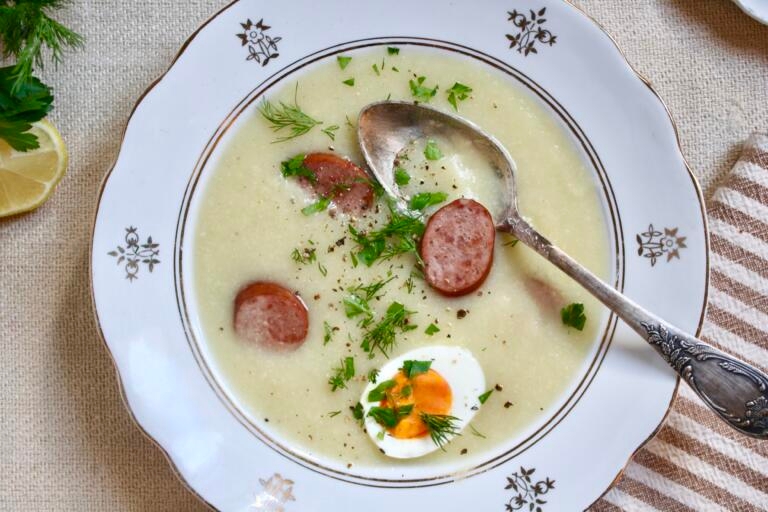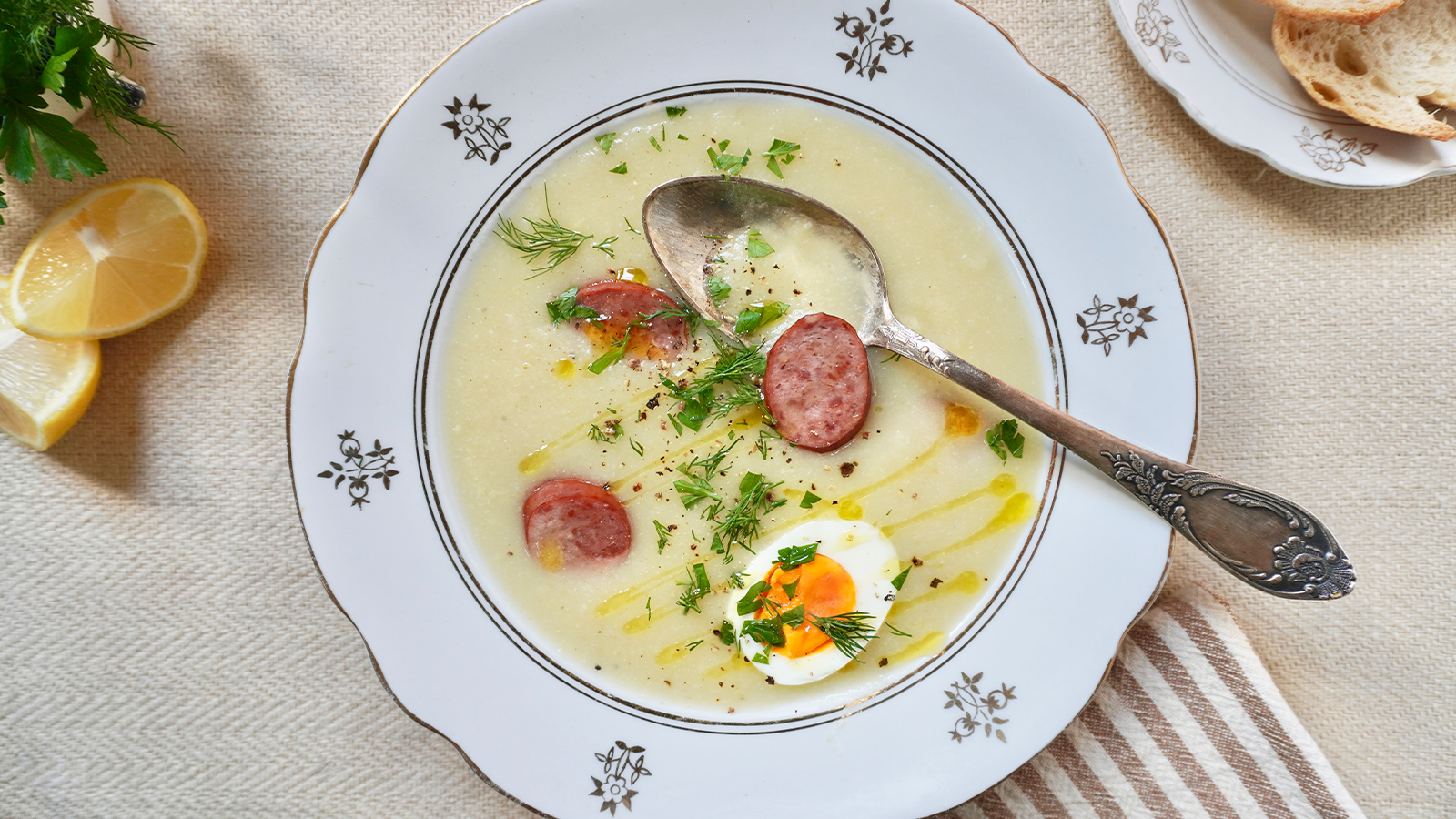What makes a borscht a borscht? I often get asked this question when I share a recipe for any variation other than the beet-based gold standard borscht.
Borscht (aka borsch or borshch) is in fact defined as a “sour soup.” Any pot of borscht requires tanginess, whether it is red, green or white. That essential sour component in borscht can be achieved from the addition of citrus, a fermented wheat starter, vinegar, pickling liquid, tomato or sauerkraut. The word “borscht” is believed to have been derived from the Slavic word for hogweed, borschevik — a plant in the carrot family that was both frequently fermented and used in soups in early Slavic cuisine. Some date the origin of borscht as far back as the 14th century Ukraine, and differing styles of borscht have long remained common across the former Soviet Union and Eastern Europe. As Ashkenazi Jews fled the Russian empire at the end of the 19th century, they helped popularize borscht in the far flung places where they emigrated, and notably in the United States.
Ukrainian cuisine is widely known for its deep scarlet beet borscht, and sometimes for its springy sorrel-laden green borscht. In Poland, borscht can take on a white form, which is also called “biały barszcz” or “zurek.” It can be referred to as Polish Easter soup, sour rye soup or sourdough soup, as it can be made with a fermented flour starter for that element of tang. Just like red borscht, you’ll find different iterations of white borscht depending on what region you’re in, what home cook you’re talking to, or what restaurant you’re eating at.
While there are many excellent recipes readily available for white borscht, I humbly offer my version, which is inspired by my family’s style of borscht, as well as my personal preferences. In this white borscht, the subtle puckeryness comes both from the inclusion of sourdough bread and fresh lemon juice, the latter being an ingredient my baba (grandmother) always added to her borscht regardless of its color.
The Nosher celebrates the traditions and recipes that have brought Jews together for centuries. Donate today to keep The Nosher's stories and recipes accessible to all.
This is all to say, make your white borscht the way that feels best to you: puree it or leave it chunky, add sourdough or rye or neither, make it with smoked sausage or keep it meat-free (see notes for more suggestions and swaps). I personally love to add mild, sweet cabbage to my white borscht, and I always top it with copious amounts of freshly chopped dill.
However you decide to tweak this hearty soup, please know it is an antidote to a chill in the air, to a sun that sets too early, to a tummy that needs filling, and it is a celebration of the humble potato and cabbage, from which so many of my ancestral dishes seem to come from. As we said in our home prior to eating, “priyatnogo appetita,” or as you might say in yours, bete’avon!
Notes:
- To make this gluten-free: Use gluten-free sourdough, or omit the bread entirely, and swap with an additional potato.
- To make this vegetarian/vegan: Omit the sausage and swap vegetable broth or vegan bouillon for chicken stock. The soup will be less smoky without sausage, but it is still a delicious vegetable soup. Make sure to season generously with salt and pepper. Top with sour cream at the end for extra richness.
- For extra texture: when adding the sliced sausage back to the pot, reserve ½ of the slices and fry them up in a pan just before serving; then top each bowl with browned rounds of the sausage. Sourdough croutons also make for a great textural topping.
- If you don’t have a blender or food processor: You can keep this soup chunky and skip pureeing it, but I’d suggest omitting the sourdough bread, and instead replacing it with more fresh lemon juice or another acidic component like vinegar or sauerkraut.
- Make ahead: White borscht lasts up to one week in the fridge, and up to three months frozen.

White Borscht
In this white borscht, the subtle puckeryness comes both from the inclusion of sourdough bread and fresh lemon juice, the latter being an ingredient my baba (grandmother) always added to her borscht regardless of its color.
- Total Time: 1 hour 15 minutes
- Yield: Serves 8-10
Ingredients
- 2 Tbsp olive oil, plus more as needed
- 1 white or yellow onion, diced
- 1 large leek, green tops trimmed, halved lengthwise then sliced
- 1 large (½ lb /230 g) parsnip, peeled and diced
- 2 stalks celery, sliced
- 3–4 cloves garlic, minced
- 3 (1 lb /500 g) Yukon Gold potatoes, diced into 2” pieces
- 1 (12 oz/340 g) package turkey kielbasa, beef kielbasa or your preferred smoked sausage
- 2 bay leaves
- 2½ quarts (10 cups) chicken or vegetable stock
- 3 cups sliced cabbage, about ½ a small cabbage
- 3 slices (3 oz /100 g) sourdough bread, crusts removed and cubed
- juice of ½ a lemon, or to taste
- ½ bunch fresh dill, chopped, for garnish
- ½ bunch fresh parsley, chopped, for garnish
- salt and pepper, to taste
- 4 hard-boiled eggs, halved (optional, for garnish)
Instructions
- To a large pot over medium heat, add the olive oil, then add the onion, leeks, parsnip and celery. Season with salt and pepper. Sauté until the vegetables begin to soften and start to become slightly translucent, about 5-6 minutes.
- Add the garlic to the pot, and sauté for an additional 2-3 minutes, or until very fragrant.
- Add the potatoes, whole kielbasa/sausage and bay leaves to the pot, then pour in the stock. Bring the liquid to a boil, then lower the heat and simmer for 25 minutes.
- Remove the kielbasa/sausage and reserve. Add the cubed sourdough bread and sliced cabbage to the pot, and simmer for an additional 20-30 minutes, or until the potatoes and cabbage are very tender.
- Turn off the heat and puree the soup using an immersion blender. Alternatively, you can use a blender or food processor and blend the soup in batches; avoid filling the blender/food processor more than ¾ full.
- Add the juice of half a lemon to the pot, taste and adjust the seasoning as desired by adding more salt, pepper or additional lemon juice.
- Slice the reserved kielbasa and add it back to the pot.
- To serve, generously garnish each bowl with freshly chopped dill and parsley, and a drizzle of olive oil. If desired, serve topped with sliced hard-boiled egg.
Notes
- To make this gluten-free: Use gluten-free sourdough, or omit the bread entirely, and swap with an additional potato.
- To make this vegetarian/vegan: Omit the sausage and swap vegetable broth or vegan bouillon for chicken stock. The soup will be less smoky without sausage, but it is still a delicious vegetable soup. Make sure to season generously with salt and pepper. Top with sour cream at the end for extra richness.
- For extra texture: when adding the sliced sausage back to the pot, reserve ½ of the slices and fry them up in a pan just before serving; then top each bowl with browned rounds of the sausage. Sourdough croutons also make for a great textural topping.
- If you don’t have a blender or food processor: You can keep this soup chunky and skip pureeing it, but I’d suggest omitting the sourdough bread, and instead replacing it with more fresh lemon juice or another acidic component like vinegar or sauerkraut.
- Make ahead: White borscht lasts up to one week in the fridge, and up to three months frozen.
- Prep Time: 15 minutes
- Cook Time: 1 hour
- Category: Side Dish
- Method: Soup
- Cuisine: Ashkenazi




My mother made both beet and spinach borscht. It was called shav.?
I don’t have the recipe.
We liked it.
Best,
John Goldman
Yes schav! Here is a recipe: https://www.myjewishlearning.com/recipe/schav/
I’ll ask my mom how she made it. She is from Poland
Schav is made with sorrel, a lemony-tasting green leafy vegetable, not spinach. Sorrel isn’t common in the US, but you might be able to find it in gourmet or ethnic markets.
Thank you for this recipe ~ I’m looking forward to making it. I was raised with my grandma and great aunt teaching me how to cook all the Slovak dishes. They had a slightly different twist to this – they added mushrooms – but I’m going to try it using your recipe. My husband is German and some of our dishes are closely related. I almost always go the Slovak way! 😉
This is almost the same recipe from my Oma! I love this light Borscht! Delicious!
It cooking on my stove top right now. The smell takes me back home to the mountains of Germany. Thank you, Shannon!
BTW, I always have liked it with challah, not sour dough. Just my own likes.
Perdón, que es chirivias? Y kielbasa?
Gracias.
Kielbasa es un tipo de salchicha, pero tu puedes cocinar eso con cualquier salchicha que preferieras; Chirivias es un tipo vegetable. Si no encuentras chirivías, también puedes sustituirlas por zanahorias.
For a vegan, smokey flavour, try adding a little chipotle.
I suspect the recipe is an acquired taste — a comfort food to those who grew up on it and a bland sour for others. The recipe has an error: step 1 should say parsnips not parsley. Do not make this if you are sensitive to inulin because it is primarily boiled and pureed aliums, which makes it very problematic. I didn’t realize that before making this and certainly regretted it after trying.
Love soup..esp. from baba.
Sadly..our special women aren’t
here.
Thx..Will try and hope it brings
back the Old Country.
C